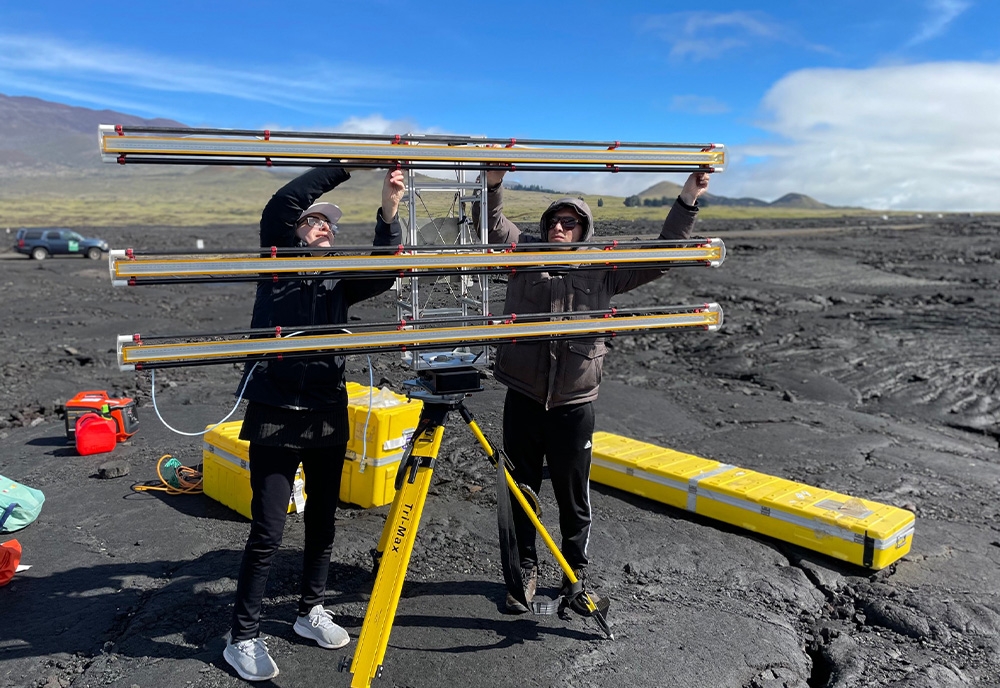We reach more than 65,000 registered users in Dec!! Register Now

Mitigating volcano hazards: USF students and alumna travel to Hawaii to study Mauna Loa eruption
- January 04, 2023
- 27 Views
- 0 Likes
- 0 Comment
A team from the University of South Florida is on the ground in Hawaii studying Mauna Loa, the largest active volcano in the world, to improve efforts that can help protect residents from lava flow. While slow-moving, lava averages 2,200 degrees Fahrenheit and destroys everything in its path.
They’re collecting data that will be used to create models that can help improve lava flow forecasting tools, such as MOLASSES – a simulation engine that forecasts inundation areas of lava flow, created by USF geosciences Professor Chuck Connor. Tools, such as MOLASSES, are useful in determining how hazards impact populations.
Connor says using the radar to gather data is essential in understanding volcano topography and improving the lava flow models.
“We want to make hazard maps that help people understand where they live and what the risks are,” Connor said. “We can’t stop a volcano from erupting, but we can give people warning about the lava flow.” Photo credit: Lis Gallant
Photo credit: Lis Gallant
Shortly after Mauna Loa’s eruption in late November – the first since 1984 – USF geosciences Professor Tim Dixon sent graduate students, Taha Chorsi and Mahsa Afra, to Hawaii with a Terrestrial Radar Interferometer, a rare, ground-based instrument that measures where the landscape is changing and how quickly those changes are occurring.
Chorsi and Afra delivered the radar to USF alumna Lis Gallant, a National Science Foundation post-doctoral research fellow at the United States Geological Survey Hawaiian Volcano Observatory.
With this radar, the USF trio were able to capture the thickening of Mauna Loa’s lava flows. The novelty of the ground-based instrument is its ability to measure the lava’s surface and create a three-dimensional map within a span of minutes.
“A lot of volcano science happens in hostile terrains,” Gallant said. “This radar is a particularly powerful instrument because it can see through moisture, and now, we can definitely say it would be well-suited in areas where visibility is poor and to immediately help hazard response.”
The team will review this data over the next several months to determine where the Mauna Loa lava flow was moving and the velocities of those movements. The data can be used to better understand how lava flows move and advance, which in turn can be used by scientists to improve tools used to forecast lava flow hazards through models.
Dixon has had great success using the radar to monitor Earth movements in glaciers, landslides, earthquakes and volcanoes. Many of his students, including Chorsi and Afra, have worked alongside him over the years to learn the radar and develop a user manual. “There’s probably only a hundred people in the world who can successfully use this instrument,” Dixon said.
“This instrument is not widely available, but fortunately USF has one,” Chorsi said. “I am very thankful that USF and Tim gave me this opportunity.”
“USF’s Natural Sciences grad programs really do cultivate the next generation of scientists,” Connor said. “I’ve been around long enough to actually see it happen – watching our students advance science is mind blowing.”
Cite This Article as
No tags found for this post









